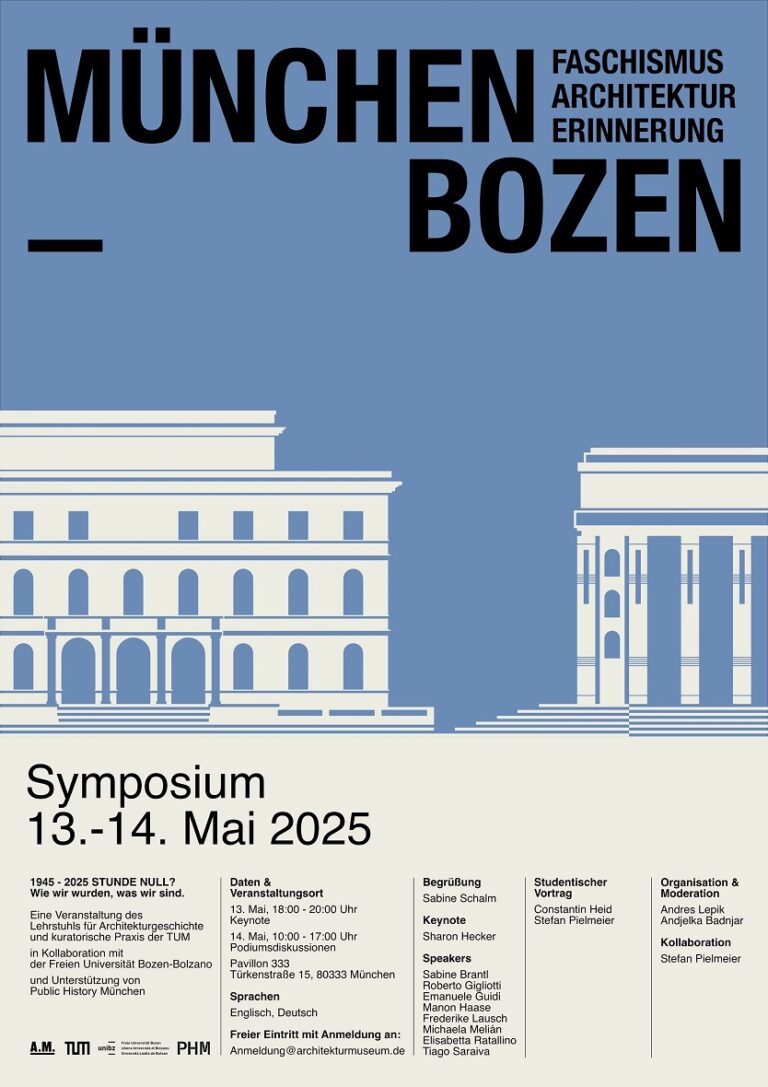MÜNCHEN — BOZEN.
Through the cases of two cities, the symposium “MÜNCHEN-BOZEN. Faschismus, Architektur und Erinnerung,“ reflects on the relationship between the aftermath of totalitarian politics, buildings and memory. Munich, “the capital of the (NS) movement”, has been addressing and, at the same time, kept struggling with unresolved spatial traces of National Socialism through the history of its streets such as Schellingstraße, existing buildings exemplified by Haus der Kunst, ruins of Ehrentempel or locations of the destroyed infrastructure of forced labour camps with a representative of Neuaubing until now standing. Even bare material still circulates chased by 1930s events such as stones from the Jewish synagogue destroyed by Nazis, which have been recently found in the waters of Isar. Bozen-Bolzano, after being integrated into Italy in 1919 and the establishment of the fascist regime in 1922 followed by Benito Mussolini’s rhetoric of superiority, became out of special interest for the Italian government due to its strategic border location and the region’s natural resources. During the Fascist Ventennio, the region underwent an extensive – yet rather unsuccessful – process of Italianization. The urbanization of Bolzano played a key role in this process, becoming one of the Italian cities with the most extensive building representation of the fascist power still visible today. In the past twenty years, this legacy has been an object of self-questioning through curating as a means for addressing the “difficult heritage” of controversial buildings such as the Monumento alla Vittoria.
Extending from the cases of the two cities, the symposium tracks resonances among memory cultures in Germany and Italy by retrospectives and tells stories facing either oblivion or permanent re-actualization. Through lives of buildings and institutions, neglected artworks, imprisoned artists, and architects opposing or propagating völkisch (nationalist) views, it questions the modalities of a culture of remembrance. Answers are sought in the establishment of criticism to infinite forms of fascism, which, following Umberto Eco historically or Alberto Toscano nowadays, continue to persist. Aiming contemporary contextualization and open discussion, we bring together curators, researchers, artists, architects and historians to answer questions such as: How places of remembrance in urban spaces and museums can help face oblivion and activate memory to reflect on the ongoing rise of intolerance and totalitarian politics? The event will consist of two panel-discussions, lectures and student sessions, in the form of a round-table setting welcoming the audience participation.
Date and Time
May 13th 18:00 – 20:00 Keynote in Pavillon 333, Türkenstraße 15
May 14th 10:00 – 17:00 Panel Discussions in Pavillon 333, Türkenstraße 15
Speakers
Welcome by Dr Sabine Schalm, Public History München and Prof. Dr Andres Lepik, Architekturmuseum der TUM
Dr Sharon Hecker, curator and art historian
Michaela Melián, artist and musician
Emanuele Guidi, curator, writer and researcher, Nuova Accademia di Belle Arti Milano
Dr Frederike Lausch, architectural historian, Departement Architektur gta ETH Zürich and Center for Critical Studies in Architecture (CCSA)
Prof. Dr Roberto Gigliotti, Professor at the Faculty of Design and Art of the Free University of Bozen-Bolzano
Dr Elisabetta Ratallino, art historian, Postdoctoral Fellow at the Bibliotheca Hertziana – Max Planck Institute for Art History in Rome
Sabine Brantl, curatorial and head of historical archive at Haus der Kunst München
Prof. Dr Tiago Saraiva, Professor at the Department of History at Drexel University Philadelphia
Manon Haase, curator and project coordinator Memorial Site Neuaubing, Munich Documentation Centre for the History of National Socialism
Moderation by Prof. Dr Andres Lepik and Dr Andjelka Badnjar
Student session with Stefan Pielmeier and Constantin Heid
Language
English/German
Registration
Participation is free of charge
Registration by sending an email to Anmeldung@architekturmuseum.de
Organised by
Chair of History of Architecture and Curatorial Practice, TUM School of Engineering and Design
Architekturmuseum der TUM
Prof. Dr Andres Lepik, Dr Andjelka Badnjar, Stefan Pielmeier
In partnership with The Free University of Bozen-Bolzano
Prof. Dr Roberto Gigliotti, Dr Elisabetta Ratallino
Supported by
Public History München
Part of the program “Stunde Null? Wie wir wurden, was wir sind.“ January – May 2025

